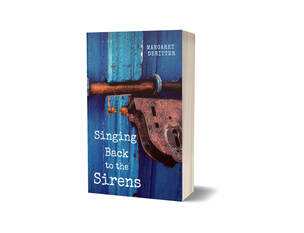Unsolicited Press
 Margaret DeRitter is the poet and author of Singing Back to the Sirens, a collection that explores the many ways that desire and love, loss and grief, can shape a woman’s life. The poems in this two-part collection look at the loneliness of a newborn for her sick mother, the first stirrings of sexual desire for a best friend, the treacherous leap from a sheltered world of faith into lesbian life, the frustrations of falling for straight women, the alchemy of falling in love, the aftermath of losing it. In the first section, the poet sings back to the many women she has loved. In the second, she sings back to the one who sang the sweetest and the saddest songs. Margaret sat down with our team and revealed some of the intimate details about her writerly world. Read on! If you could cook dinner for any author, dead or alive, who would it be? What would you make? Emily Dickinson, because I’d want to be able to tell her how important she has become in American literature and in the lives of so many poets, including myself. I’d serve her anything she’d ask for, since she never got what she wanted from the literary world during her lifetime. What scares you the most about the writing process? How do you combat your fears? I don’t think it scares me, but I do get frustrated if I feel I can’t come up with words that do justice to an idea I want to express in a poem. What I do then is just keep revising and doing the best I can, or I let the poem sit for a while and come back to it with fresh eyes. Who is your biggest literary crush, author or character? The casino worker Ann Childs in “Desert of the Heart.” by Jane Rule. She’s wild, sexy and full of life and not afraid to pursue the woman she wants. And Patricia Charbonneau, the woman who plays her character (albeit with a different name, Cay Rivers) in the movie “Desert Hearts,” is so beautiful that I found myself keeping an eye out for her on a vacation in my early 30s after finding out she lived in New York State. She never did materialize there, but I did see her once on TV. What books are on your nightstand? The Hours,” by Michael Cunningham; “Mrs. Dalloway,” by Virginia Woolf; and “Delights & Shadows,” Ted Kooser’s poetry collection. “The Hours” made me want to read “Mrs. Dalloway,” and I was not disappointed.. The writing style was different from anything I’d ever encountered, and many of the sentences read like poetry. Kooser blew me away with his ability to imbue everyday objects and activities with a sense of the sacred. Where do you get your ideas? What inspires you? I get my ideas mainly from incidents that make an emotional impact on me. I also get ideas from observing the natural world outside my windows or on woods walks. Really good writing, like that of my first poetry-writing teacher, Diane Seuss, inspires me to push myself harder as a writer. The women in my writing group, Poetry Dawgs, which I’ve been part of for 20 years or so, also inspire me with their enduring friendship, good humor and astute feedback. Favorite punctuation mark? Why? My favorite punctuation mark is the comma. It has so many uses, and its addition to or omission from a sentence can vastly change its meaning, as in “Now I must go and get on, my lover” vs. “Now I must go and get on my lover.” What book were you supposed to read in high school, but never did? I was a good girl then and always did my required reading. Now some friends seem to think I’m required to read the Harry Potter books, but I’m really not interested. What inanimate object would you thank in your acknowledgements? My Macbook Air, so light I can take it anywhere to write. Why do you write? The first 5 words that come to mind. Go. To survive and make a mark. OK, that’s six. If you could write an inspirational quote on the mirrors of aspiring writers, what would you write? "Get it down. Take chances. It may be bad, but it's the only way you can do anything really good." — William Faulkner Comments are closed.
|
Popular Topics
All
We Support Indie Bookshops |
